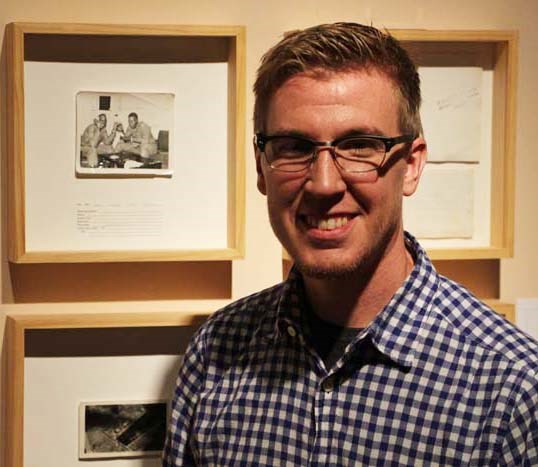A picture might say a thousand words, but it doesn’t necessarily tell the full story. Partial Identities, now running at the Godfrey Dean Art Gallery, features two North Dakota artists, Ryan Stander and Jessica Christy, exploring found objects and photographs to look at ideas of identity and history.
The genesis for the show began in two places. In Cyprus, where Stander worked at a museum as an artist in residence, he was struck by sheer amount of pottery archived in the back room, shelves upon shelves of it cataloged after archaeological digs.
The photos themselves began with a school photo from 1955 that Stander found on the floor of a mall and kept with him. It became an art project when Stander found a shoebox of old photos at a flea market, and found it to be sad that the photos themselves were now discarded artifacts of the people who owned them.
“There was a similarity between the pottery and these lost photographs, that was the impetus for putting it in archival form. In a way I’m more of a curator of images.”
He says that for many people there is a strong sense of loss, because the photos have become disassociated with the people in the photos and their stories.
“I’m trying to get people to think about memory, the loss of memory, and what are the photographs themselves and what is going to happen to your photographs when you leave this place.”
The photos are largely sourced from eBay, and Stander says that he will buy large bags of photos at a time, sometimes buying thousands in a single auction, paying an average of eleven cents per image.
Those images are handled in various different ways, whether making different styles of print or collecting them in various different boxes. There are also trays where people can sort through the photos themselves, something Stander admits that was not his original intent, but driven by the fact that people could not resist handling the images.
“They’re handheld objects, so the more that I thought about it, it seemed like the right thing to do. Let people touch them and sort through them, have a first hand actual encounter with the work so they can reconsider it. It’s not just a mental or visual engagement, but it’s a physical engagement with the object.”
There’s also a history of the medium wrapped up into the show as well, as the wide range of formats and printing methods are represented through the show. With the world moving to an increasingly digital view of photography, rarely actually printing any images, Stander says it’s slowly becoming rare for people to actually handle photographs.
“There was just so much more diversity in photo printing than what there is today.”
In spite of the sheer number of lost photos, nobody has ever found themselves in the images. Stander says if someone could prove it was them he would be happy to give them the photo.
“These are really precious things, these photographs, and I feel as though I am just the caretaker right now. If I could reunite a family and its photos I would be really excited about that, but it’s never happened.”
Partial Identities runs until August 25 at the Godfrey Dean. Stander also says that he’s always on the hunt for photos to add to the project, and he can be found at www.ryanstander.com.




